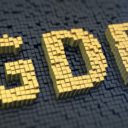U.S. first quarter GDP growth, not surprisingly, was more tepid than previously estimated in the first quarter. Economists are citing that the economy was held back by a moderate pace of consumer spending, weak business investment and declining exports.
Gross domestic product expanded at a 1.8 percent annual rate, the Commerce Department said in its final estimate on Wednesday. Output was previously reported to have risen at a 2.4 percent pace after a 0.4 percent stall speed in the fourth quarter.
Economists polled by Reuters had expected first-quarter GDP growth would be left unrevised at 2.4 percent. When measured from the income side, the economy grew at a 2.5 percent rate, slower than the fourth-quarter’s brisk 5.5 percent pace.
Details of the report, which showed downward revisions to just about all growth categories, with the exception of home construction and government, which an argument could certainly be made that the two are one-in-the-same. The news could cast a shadow over the Federal Reserve’s fairly upbeat assessment of the economy last week.
Though the data is fairly backward looking, it comes as the financial market conditions have floundered after Fed Chairman Ben Bernanke said last week the U.S. central bank would likely begin to slow the pace of its bond-buying stimulus later this year and stop the program in 2014.
Economists fear that could undercut growth, which has recently shown signs of picking up.
Consumer spending, which of course accounts for more than two-thirds of U.S. economic activity, increased at a 2.6 percent pace rather than 3.4 percent. The revision largely reflected weak outlays on health care services.
Consumer spending grew at a 1.8 percent rate in the fourth quarter of last year.
Exports, previously reported to have grown, actually contracted at a 1.1 percent pace in the first quarter, cutting 0.15 percentage point from GDP growth. That likely reflects a slowdown in the global economy.
Business spending barely grew, with investment on nonresidential structures declining more sharply than previously reported. The drop in spending on nonresidential structures was the first in two years.
The pace of inventory accumulation was revised marginally down as well, adding just a little more than half a percentage point to GDP growth. Excluding inventories, GDP grew at a 1.2 percent rate, which is the slowest rate in two years. Prior to the latest GDP news, stocks had been making gains, while gold fell. However, the gains have been pared back as investors contemplate a safe haven.






